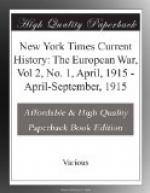South of the La Bassee Canal the Connaught Rangers of the Ferozepore Brigade had not been attacked. North of the canal a short length of our original line was still held by the Ninth Bhopals and the Fifty-seventh Rifles of the same brigade. Connecting with the latter was the First Brigade, holding the village of Givenchy and its eastern and northern approaches. On the left of the First Brigade was the Third Brigade. Tenth had been lost between the left of the former and the right of the latter. The Third Brigade held a line along, and in places advanced to, the east of the Festubert Road. Its left was in communication with the right of the Meerut Division line, where troops of the Second Brigade had just relieved the First Seaforth Highlanders. To the north, units of the Second Brigade held an indented line west of the orchard, connecting with half of the Second Royal Highlanders, half of the Forty-first Dogras, and the First Battalion Ninth Gurkha Rifles. From this point to the north the Ninth Jats and the whole of the Garhwal Brigade occupied the original line which they had held from the commencement of the operations.
The relief of most units of the southern sector was effected on the night of Dec. 22. The Meerut Division remained under the orders of the First Corps, and was not completely withdrawn until Dec. 27.
In the evening the position at Givenchy was practically re-established, and the Third Brigade had reoccupied the old line of trenches.
During the 23d the enemy’s activities ceased, and the whole position was restored to very much its original condition.
In my last dispatch I had occasion to mention the prompt and ready help I received from the Lahore Division, under the command of Major Gen. H.B.B. Watkis, C.B., which was thrown into action immediately on arrival, when the British forces were very hard pressed during the battle of Ypres-Armentieres.
The Indian troops have fought with the utmost steadfastness and gallantry whenever they have been called upon.
Weather conditions were abnormally bad, the snow and floods precluding any active operations during the first three weeks of January.
5. At 7:30 A.M. on Jan. 25 the enemy began to shell Bethune, and at 8 A.M. a strong hostile infantry attack developed south of the canal, preceded by a heavy bombardment of artillery, minenwerfers, and, possibly, the explosion of mines, though the latter is doubtful.
The British line south of the canal formed a pronounced salient from the canal on the left, thence running forward toward the railway triangle and back to the main La Bassee-Bethune Road, where it joined the French. This line was occupied by half a battalion of the Scots Guards, and half a battalion of the Coldstream Guards, of the First Infantry Brigade. The trenches in the salient were blown in almost at once, and the enemy’s attack penetrated this line. Our troops retired to a partially prepared second line, running approximately due north and south from the canal to the road, some 500 yards west of the railway triangle. This second line had been strengthened by the construction of a keep half way between the canal and the road. Here the other two half battalions of the above-mentioned regiments were in support.




